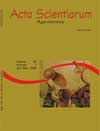<b>Potential of <em>Chrysoperla externa</em> (Hagen) at B-biotype <em>Bemisia tabaci</em> (Gennadius) nymphs control in tomato plants</b> - DOI: 10.4025/actasciagron.v29i1.62
Abstract
This study aimed to evaluate the potential of Chrysoperla externa (Hagen, 1861) in controlling nymphs of Bemisia tabaci (Gennadius, 1889), biotype B, in tomato plants. Ninety-six pots, each with one whiteflyfree plant, were placed in cages at greenhouse and each plant was infested with 100 adult whiteflies for 24 hours. In the first and eighth days after nymph eclosion, infested plants were inoculated with one, five and ten larvae of the first, second and third C. externa instars, excepting the control plants. The number of nymphs that escaped predation was counted on the eleventh day after prey eclosion. Totally casualized delineation was used, with 3 x 4 factorial scheme and eight repetitions. The C. externa larvae released in the first day after whitefly nymph eclosion were most efficient in reducing prey population at 10 larvae per plant, ensuring roughly 50% pest control. When released on the eight day after nymph eclosion, at densities of five and ten C. externa larvae per plant, a pest density reduction of approximately 40% was observed. Therefore, releasing C. externa larvae on tomato plants kept individually in cages is efficient to control B-biotype B. tabaci.Downloads
Download data is not yet available.
Published
2007-08-20
How to Cite
Auad, A. M., Carvalho, C. F., Souza, B., Simões, A. D., Oliveira, S. A., Braga, A. L. F., & Ferreira, R. B. (2007). <b>Potential of <em>Chrysoperla externa</em> (Hagen) at B-biotype <em>Bemisia tabaci</em> (Gennadius) nymphs control in tomato plants</b> - DOI: 10.4025/actasciagron.v29i1.62. Acta Scientiarum. Agronomy, 29(1), 29-32. https://doi.org/10.4025/actasciagron.v29i1.62
Issue
Section
Crop Protection
DECLARATION OF ORIGINALITY AND COPYRIGHTS
I Declare that current article is original and has not been submitted for publication, in part or in whole, to any other national or international journal.
The copyrights belong exclusively to the authors. Published content is licensed under Creative Commons Attribution 4.0 (CC BY 4.0) guidelines, which allows sharing (copy and distribution of the material in any medium or format) and adaptation (remix, transform, and build upon the material) for any purpose, even commercially, under the terms of attribution.
2.0
2019CiteScore
60th percentile
Powered by 

2.0
2019CiteScore
60th percentile
Powered by 



















































